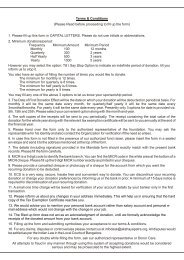The Top 100 NGOs 2013. - Akshaya Patra
The Top 100 NGOs 2013. - Akshaya Patra
The Top 100 NGOs 2013. - Akshaya Patra
Create successful ePaper yourself
Turn your PDF publications into a flip-book with our unique Google optimized e-Paper software.
<strong>The</strong> gloBal review + Books <strong>The</strong> gloBal review + Books<br />
WHO kILLEd THE HIPPOCRATIC OATH? FITTING IN THE CHATTERING CLASSES A NEW BIOSOCIAL CONTRACT THE RETURN OF THE VEIL<br />
thieveS of virtUe: When<br />
bioethicS Stole Medicine<br />
Tom koch<br />
<strong>The</strong> miT Press<br />
£20.95<br />
Born in the 1960s, bioethics was to<br />
bring “a specific kind of analytic, moral<br />
philosophy to questions of medical care<br />
and healthcare delivery.” In this wellresearched<br />
book, Tom Koch explains<br />
why contemporary bioethics fails to<br />
fulfill its role – to the detriment of<br />
patients, research subjects and citizens.<br />
Under the old Hippocratic Code,<br />
medical practitioners were caregivers<br />
of the individual as well as society<br />
at large. <strong>The</strong> code was idealistic and<br />
simplistic: some acts were encouraged<br />
and others – such as abortion or<br />
euthanasia – prohibited. But the<br />
clinical, environmental and social<br />
elements of the Hippocratic vision also<br />
provided a guide as to how health could<br />
be promoted. It was left for societies<br />
to find the balance between economic<br />
constraint and human necessity.<br />
In the late 19th century, however,<br />
the focus shifted from patient care<br />
and communal responsibility to<br />
individual autonomy and economic<br />
efficiency. Practitioners were elevated<br />
to authoritative positions as medical<br />
judges, including the power to decide<br />
whether to give, withhold, withdraw<br />
or continue care. <strong>The</strong> new goal of<br />
medicine through fundamental research<br />
became “the definition of the acceptable<br />
person within a population whose<br />
composition could be controlled to the<br />
advantage of the state and<br />
its economies.”<br />
Borrowing from Confucius, Koch<br />
warns us against “thieves of virtue” –<br />
bioethicists who promote as universal<br />
a perception of medical ethics whose<br />
end is moral action. <strong>The</strong>y teach, write,<br />
advise hospitals and review boards,<br />
and generally serve as “surrogates<br />
of the general public” when ethical<br />
issues arise in practice and research.<br />
While bioethicists present the scarcity<br />
of medical services as natural, Koch<br />
argues that scarcity is the predictable<br />
result of “economic choices and political<br />
decisions made with full knowledge<br />
of the dire consequences.” Scarcity<br />
disappears when the US Congress<br />
votes to fund dialysis as a national<br />
entitlement, or when local health<br />
boards argue for urban sanitation and<br />
preventive measures against epidemics.<br />
As political actors and social<br />
participants, bioethicists shape health<br />
policy. <strong>The</strong>ir assumptions define<br />
life, health and normalcy; the care or<br />
non-care of persons depends on their<br />
perspective on the human condition.<br />
Through various case studies, Koch<br />
explains that bioethicists can – and<br />
do – regularly deny care for those with<br />
limiting cognitive, physical or sensory<br />
attributes, advocating the right to die<br />
as an individual choice rather than<br />
the right to live with dignity<br />
despite difference.<br />
Koch’s critique is an appeal for a<br />
transformed medical ethics that is<br />
humanist, responsible, and defensible.<br />
A fundamental question to be revisited<br />
is whether we understand society as an<br />
economic enterprise in which patients<br />
are consumers, or a “social covenant<br />
in which all are able to participate…<br />
irrespective of their physical abilities.”<br />
- AS<br />
<strong>The</strong> gloBal Journal + January & FeBruary 2013<br />
Early in Fit, Robert Geddes – dean<br />
emeritus at the Princeton School of<br />
Architecture and distinguished urbanist<br />
– notes that “what we build is a result of<br />
what we are.” Subtitled “an architect’s<br />
manifesto,” this slim but elegant volume<br />
sets out to assert in clear terms that<br />
buildings, landscapes and cities should,<br />
therefore, be designed to “fit” – fit the<br />
purpose, fit the place, and fit for<br />
“future possibilities.”<br />
As such, Fit is a riposte to notions of<br />
‘exclusive’ architecture or “architecture<br />
for its own sake.” Geddes seeks to<br />
challenge both the enduring legacy<br />
of modernist dogma – form follows<br />
function – and its diametric opposite, an<br />
architecture judged largely on aesthetics<br />
rather than its engagement with<br />
prevailing social and environmental<br />
conditions. In order to ground his<br />
arguments, the author steps the reader<br />
through a series of succinct chapters<br />
focused on the experiential role of<br />
nature, the functional and expressive<br />
qualities of design, and the legacy of<br />
architectural form.<br />
Evidently targeting a generalist<br />
audience, Fit, though measured in its<br />
narrative, and peppered with literary<br />
and other references, also suffers as<br />
a result of its self-imposed simplicity.<br />
Geddes raises countless truths that<br />
help to illuminate a subject often<br />
impenetrable to ‘outsiders.’ At the same<br />
time, however, one is left with a sense<br />
of why architecture matters, but not the<br />
new beginning the book promises.<br />
- AK<br />
fit: an architect’S<br />
ManifeSto<br />
roBerT geDDes<br />
PrinceTon universiTy<br />
Press<br />
$19.95<br />
What impact can 140-character<br />
messages have in our everyday lives<br />
and on influential social movements?<br />
<strong>The</strong>se are the questions Dhiraj Murthy,<br />
a sociology professor, seeks to address<br />
in his engaging new book Twitter.<br />
Although one of the most used social<br />
media globally, Murthy’s study is the<br />
first that deals critically with the effects<br />
of Twitter on the “real world,” and<br />
how it has shaped our contemporary<br />
communication style.<br />
To this end, Murthy places Twitter<br />
in historical perspective, drawing<br />
links with earlier technologies like the<br />
telegraph and radio. He then proceeds<br />
through a series of case studies<br />
encompassing a variety of sectors – from<br />
global health, to disaster coordination<br />
and, of course, political activism.<br />
What Murthy demonstrates successfully<br />
is that though Twitter is only a young<br />
communications device, it has the<br />
potential to be very potent. At the same<br />
time, he presents this argument in a<br />
balanced way, exposing the myth that<br />
Twitter is all-powerful. Instead, Murthy<br />
emphasizes that it remains a tool, albeit<br />
one that can be used for great purposes<br />
by its (human) users. Similarly, his<br />
reflections on our “update culture”<br />
and ambient news are remarkable. <strong>The</strong><br />
200,000 million tweets sent each day<br />
have been deserving of serious scholarly<br />
attention. Murthy addresses this gap in<br />
a pioneering book.<br />
<strong>The</strong>gloBalJournal.neT<br />
128 129<br />
- JM<br />
tWitter: Social<br />
coMMUnication in the<br />
tWitter aGe<br />
DhiraJ murThy<br />
PoliTy Press<br />
£50.00<br />
At the outset of <strong>The</strong> Fair Society, Peter<br />
Corning, Director of the Institute for<br />
the Study of Complex Systems, asks<br />
some fundamental questions about<br />
human development and social justice.<br />
Most crucially, if we perceive life as<br />
unfair, do we have the power to change<br />
society for the better?<br />
In this provocative new book, Corning<br />
suggests that selfishness is in fact not<br />
a natural human trait, and is instead<br />
grounded in biological, anthropological,<br />
sociological and organizational<br />
evolution. As the basis for affirming<br />
‘yes, we do care,’ he points to the<br />
two dominant aspects of our nature:<br />
survival and reproduction. With a<br />
moral definition of justice and fairness<br />
inspired by the works of Plato and<br />
Aristotle, Corning emphasizes the<br />
centrality of the “collective survival<br />
enterprise” to humankind, arguing<br />
this compels us to focus on meeting<br />
our “shared survival and reproductive<br />
needs.” According to the author, these<br />
needs are not only primarily physical –<br />
such as nutrition – but also mental; for<br />
instance, the desire for social security<br />
and talent development.<br />
Ultimately, in using cutting edge<br />
research in the behavioral and biological<br />
sciences to paint a more sympathetic<br />
and hopeful picture of human nature,<br />
<strong>The</strong> Fair Society is an appeal for a new<br />
collective focus on equality, equity<br />
and reciprocity to heal an increasingly<br />
fragmented political and social life.<br />
- AH<br />
the fair Society: the<br />
Science of hUMan<br />
natUre and pUrSUit of<br />
Social jUStice<br />
PeTer corning<br />
universiTy oF chicago<br />
Press<br />
$17.00<br />
<strong>The</strong> hijab is back – on an increasing<br />
number of women’s heads, and as a<br />
subject of public debate. This discussion<br />
is often premised on contentious and<br />
stereotypical images of veiled women<br />
as a reflection of Islamic oppression.<br />
To what extent is the veil’s resurgence a<br />
reaction to these perceptions? Are there<br />
different meanings to the hijab? What<br />
do Muslim women – veiled and unveiled<br />
– have to say about their choices? <strong>The</strong>se<br />
are just some of the questions that<br />
Harvard professor Leila Ahmed poses<br />
in A Quiet Revolution.<br />
Ahmed provides an interesting historical<br />
analysis of the issues surrounding the<br />
hijab since the beginning of the 20th<br />
century, before exploring in detail the<br />
“unveiling movement” in Egypt. She<br />
then reflects upon the revival of Islam<br />
in the United States, and the different<br />
forms of activism that have emerged as<br />
a result. A key theme throughout is the<br />
connection between the reappearance of<br />
the hijab in the East and West. Ahmed<br />
argues that understanding the situation<br />
in Egypt – a non-Islamist society that<br />
went from unveiled to predominantly<br />
veiled in less then 30 years – will help<br />
shed light on contemporary dynamics in<br />
the West.<br />
Most importantly, she demonstrates<br />
how religious movements are not<br />
static. <strong>The</strong>y can transform across<br />
frontiers and generations “and take<br />
root in environments where new<br />
social and political conditions open<br />
up new possibilities of belief, practice<br />
and interpretation.”<br />
- ZK<br />
a qUiet revolUtion:<br />
the veil’S reSUrGence,<br />
froM the Middle eaSt to<br />
aMerica<br />
leila ahmeD<br />
yale universiTy Press<br />
$30.00





